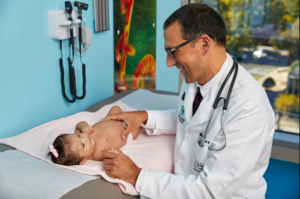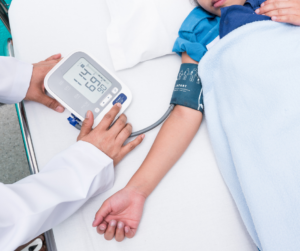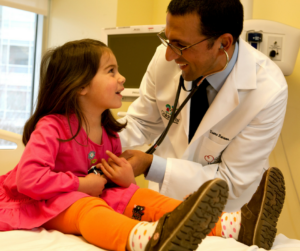Q&A with Dr. Kanaan: Pulmonary Hypertension
Director of the Pulmonary Hypertension Program at Children’s Healthcare of Atlanta Heart Center Usama Kanaan, MD, discussed pulmonary hypertension and its treatment by the multidisciplinary team he leads at Children’s Healthcare of Atlanta Cardiology.
Q: What is pulmonary hypertension?
A: Pulmonary hypertension is a relatively rare disorder of the arteries in the lungs that results in elevated blood pressure in the lungs and strain on the right side of the heart.

Q: What are the symptoms of pulmonary hypertension?
A: Symptoms vary depending on the age of the patient and the severity of the condition. The most common symptom doctors see, especially in older children, is shortness of breath with exercise and activity. Sometimes there is fainting or chest pain with exertion. More rarely, doctors may observe signs of congestive heart failure, like swelling in the legs.
Q: When do you typically see the condition emerge?
A: There are many different forms of pulmonary hypertension, which can occur at different ages. One form called persistent pulmonary hypertension of the newborn (PPHN) is exclusive to newborns, while idiopathic pulmonary arterial hypertension (IPAH) typically peaks in middle age but can also be seen in children.
Q: What are the common causes and risk factors?
A: Sometimes, pulmonary hypertension has no known cause, but it occurs more frequently as a consequence of another disease, such as congenital heart disease, or it can be associated with lung disease of prematurity in babies. Less commonly, it can be associated with autoimmune disorders, lupus, scleroderma, sickle cell disease and other systemic conditions.
Q: How treatable is pulmonary hypertension?
A: How curable pulmonary hypertension is depends on the type. Most babies whose pulmonary hypertension is associated with prematurity will outgrow the disease. Other forms tend not to resolve, and in these cases, pulmonary hypertension is a chronic, progressive disease that can eventually lead to death or lung transplantation.
Treatment depends on whether doctors can find another contributing cause or an underlying condition. If there is, they work to optimize treatment of that condition. Where there is no other cause or treatment of the underlying cause has been optimized, medications known as pulmonary vasodilators can be used to relax the blood vessels in lungs and produce a positive impact on the functioning of the right side of the heart and overall vascular health. 
Q: What do you want families to know about PH?
A: If a child is at risk for pulmonary hypertension, such as they have a repaired CHD, and they have shortness of breath with exertion or fainting, families and doctors should consider pulmonary hypertension as a potential cause. Early identification is important to allow for treatment to slow the progression of the disease.
“The multidisciplinary pulmonary hypertension team has three pulmonologists, three cardiologists and three wonderful nurse practitioners, who provide the glue that holds the program together,” Dr. Kanaan said. “We form strong relationships with our patients, and I’m fortunate to be part of such an excellent team.”
For more information about Children’s Healthcare of Atlanta Cardiology and our pediatric cardiology specialists, click here.
